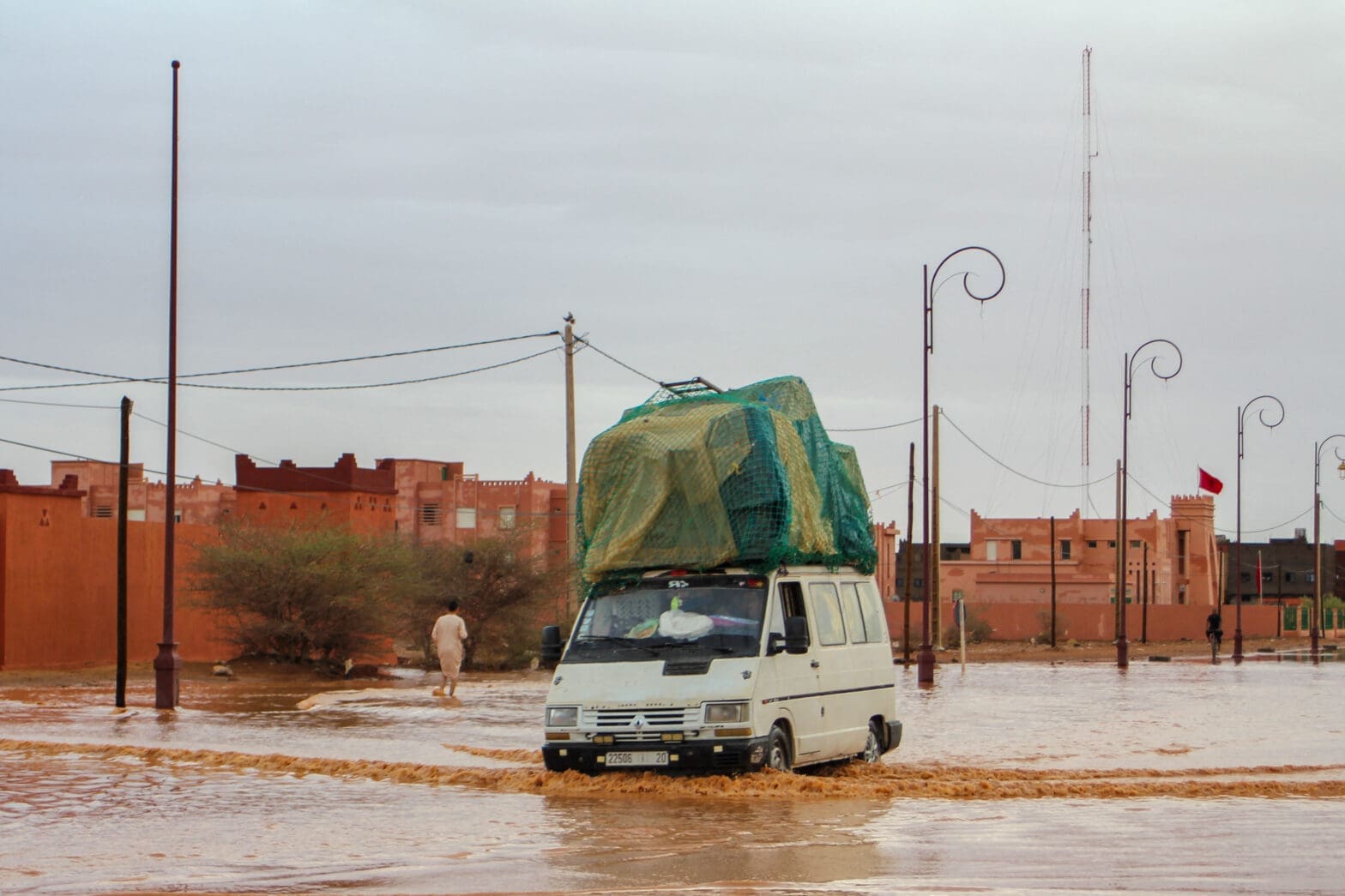
Tracking Climate Policy Uncertainty in MENA
Issue Brief, September 2024
Key Takeaways
Higher Climate Policy Uncertainty in MENA: Our climate policy uncertainty tracker (CPUT) based on news media analysis indicates that the Middle East and North Africa (MENA) region is similar to other regions in the Global South in facing higher climate policy uncertainty compared to Europe and North America.
The Trade-Off Between Development and Sustainability: MENA countries face a critical balancing act: pursuing rapid economic development while adopting sustainable environmental practices—a challenge not faced by advanced economies in the past. Higher climate policy uncertainty may hinder investments in green technologies.
Economic and Governance Factors in MENA: Heavy reliance on hydrocarbon revenues in MENA, together with limited influence in global climate governance, breeds mistrust towards aggressive climate mitigation efforts and international mechanisms aimed at combating climate change, thereby contributing to heightened regional policy uncertainty.
Voices from the Global South: Countries in the Global South, including those in the MENA region, have limited influence in global climate policy discussions, which can result in the adoption of externally imposed strategies that lack local ownership and may foster implementation uncertainties. Hosting key international events, like the United Nations Climate Change Conferences of 2022 and 2023 (COP27 and COP28), signals a growing push for more inclusive decision-making.
Introduction
In an era where the call to action against climate change echoes across continents, the world finds itself at a pivotal juncture. The unmistakable signs of climate change—rising sea levels, unpredictable weather phenomena, and altered agricultural landscapes—present a multifaceted challenge with far-reaching implications. These phenomena, which transcend mere environmental concerns to touch upon socio-economic spheres, have set off alarm bells,1 signaling an urgent need for a cohesive global response.2 As billions grapple with the consequences of these shifts, including heightened food scarcity, forced migration, and jeopardized livelihoods, the interdependence of our planet’s health and human prosperity has never been more apparent. These crises call for a robust, unified approach to mitigate the adverse effects of climate change and safeguard the future of our global community.
While international collaboration is undeniably crucial for tackling climate change, a central challenge looms: how can this collaboration be truly effective when the burdens and decision-making powers are so unevenly distributed? Historically, advanced economies have been the principal contributors to global greenhouse gas emissions—a byproduct of rapid industrialization and economic growth. These countries benefited from unrestricted emissions to reach their current state of development but are now formulating and implementing policies aimed at mitigating climate change and asking developing economies to participate in these efforts. Yet, advanced economies set policies and regulations that have implications far beyond their borders, influencing global markets, international trade, and the economic development trajectories of nations worldwide.
This disparity has profound consequences for developing nations. While advanced economies wrestle with green transitions, the Global South faces a far more complicated equation. Many of these nations aspire to achieve greater prosperity, but the global imperative to address climate change places additional uncertainty on their development agendas. While necessary for global sustainability, the stringent climate policies and regulations that advanced economies initiate often translate into significant challenges for developing nations. Global South nations are required to balance their developmental goals with the need to integrate sustainable practices and adhere to international climate agreements. This balancing act is fraught with uncertainty, as it involves navigating a rapidly evolving policy landscape, fluctuating financial and technological support, and the inherent unpredictability of environmental impacts.
MENA countries have similar tradeoffs and deepening climate change-related uncertainties, such as water scarcity as a potential driver of conflict.3,/sup> The transition from hydrocarbon dependence to clean energy sources is reshaping regional geopolitics. For instance, Saudi Arabia’s Vision 2030 aims to diversify its economy away from oil, promoting investments in renewable energy and other sectors. This shift is leading to new economic alliances and altering traditional regional power dynamics. Countries that historically relied on oil exports now seek to build partnerships in renewable energy, green technology, and other emerging industries, potentially reducing their geopolitical leverage tied to fossil fuel exports. Furthermore, regional droughts are expected to intensify in severity and frequency, affecting food production and increasing reliance on food imports. This situation makes the region sensitive to fluctuations in global food supply chains and markets, as the war in Ukraine’s impact on wheat imports demonstrated.4 Additionally, water scarcity could act as a catalyst for conflict and even be used as a weapon, as evidenced by the Islamic State’s control over key dams.5
In this evolving landscape, understanding the nuances of climate policy discussions is crucial. Nations face the complex task of economic growth alongside a sustainable transition. Climate policy uncertainty, which refers to the lack of clarity or predictability surrounding government actions and regulations related to climate change, adds an additional layer of complexity to this challenge. This can manifest in several ways, including frequent regulatory changes, conflicting policy signals, or uncertainty about future policy directions. Factors in MENA, such as the region’s dependence on fossil fuels, political instability in some countries, and the challenge of balancing economic development with environmental sustainability heighten this uncertainty.
With this context in mind, we present the climate policy uncertainty tracker (CPUT). Developed using news media analysis, this index serves as a barometer for measuring the uncertainty surrounding climate policies. By evaluating how often climate policies are mentioned in news media, the CPUT measures the evolving level of attention and uncertainty within global climate policy discussions. This issue brief argues that the CPUT reveals a higher climate policy uncertainty trend in Global South nations, including MENA countries, compared to those in Europe and North America, and that this disparity can have significant implications for investment in green technologies and the overall transition to low-carbon economies.
Tracking Uncertainty in Climate Policy: A Novel Measurement Approach
The complex challenges climate policy uncertainty poses in the Global South, particularly for sustainable development and investment in green technologies, underscore the urgent need for reliable and comprehensive measurement tools. Recognizing this need, we developed the CPUT to capture the dynamics of climate policy uncertainty across different regions and periods. This tool operates on the principle that news media accurately reflect the public discourse regarding climate policy debates, with their reporting serving as a primary barometer for the prevailing climate policy atmosphere and a predictive marker for prospective policy alterations. The CPUT analyzes the prevalence of news articles concerning climate policy using a high-frequency analytical approach, aiding in the global tracking of related shifts and uncertainties.
The CPUT builds upon an established methodology for tracking economic policy uncertainty,6 expanding its scope and precision for greater global applicability. Using data aggregated from over 150,000 global news outlets and sources, we constructed a specialized lexicon of terms relating to “climate,” “policy,” and “uncertainty” (table 1). Each article selected for analysis must contain at least one term from each category. Analyzing relevant news articles—targeting and precisely extracting relevant articles using artificial intelligence (AI) methodologies—we pinpointed those that specifically intersect these three areas, ensuring the CPUT accurately reflects climate policy uncertainty. Then, we normalized the CPUT by the total number of articles for each country.7
Table 1: Lexicon of Terms for Climate Policy Uncertainty
| Component | Example Terms |
| Climate | carbon dioxide, climate change, greenhouse gas emissions, global warming, renewable energy |
| Policy | regulation, legislation, government, agency |
| Uncertainty | uncertain, uncertainty |
The CPUT offers a high-resolution window into climate policy uncertainty across the globe. We constructed this comprehensive dataset by analyzing news media in 89 countries spanning a decade (2013–2023), with a weekly update frequency. This granular approach allows for in-depth comparisons between regions, fostering a deeper understanding of how policy uncertainty varies geographically. The CPUT’s strength lies in its global scope and its systematic methodology, ensuring a robust and nuanced view of the landscape of climate policy uncertainty. This empowers policymakers, researchers, and stakeholders to make informed decisions by providing insights into the complexities of climate policy discussions across diverse regions.
Country and Regional Comparison
Figure 1 provides a visual comparison of the CPUT results across different countries around the world. The varying shades from green to red indicate the levels of climate policy uncertainty, with green representing lower levels and red indicating higher levels. Figure 1 shows that there is a diverse range of climate policy uncertainty across the globe. Countries with higher levels of uncertainty could be experiencing significant debates regarding, and fluctuations in, their climate policy, potentially due to political contention, economic factors, or societal disagreements on how to address climate change.
Moreover, these regions are often not involved in the design of global policy regulations on climate change, despite being heavily affected by these measures. These countries might face challenges in attracting investment in green technologies and sustainable infrastructure due to the higher perceived risks by investors, as the next section will examine.
In contrast, the countries shown in green that exhibit lower levels of uncertainty likely have more stable and clear climate policies. This stability can foster a more favorable environment for investments in renewable energy and other green initiatives, as investors and companies can confidently make long-term plans.
Figure 1: Global Snapshot of Climate Policy Uncertainty
Note: The color gray indicates that we have not constructed a CPUT index for the corresponding country.
Source: The authors created this map based on their CPUT, which uses data from the Bloomberg Terminal.8
This global snapshot underscores the importance of clear and consistent climate policies for environmental outcomes and economic development. It also shows that climate change disproportionately affects countries with high uncertainty scores. Countries with lower CPUT scores can serve as models for those seeking to reduce their policy uncertainty. Conversely, higher uncertainty scores indicate that those countries can improve in the areas of policy clarification, stakeholder engagement, and legislation to foster a more predictable climate policy landscape. This map serves as a tool for policymakers, researchers, and investors to identify areas of concern and opportunity, emphasizing the global nature of climate change challenges and the varying degrees of preparedness and response efficacy among nations.
Figure 2, presenting the regional averages of the CPUT over the sample period, visualizes how different regions experience varying levels of climate policy uncertainty. Notably, regions such as Sub-Saharan Africa, South Asia, and MENA exhibit higher uncertainty levels than Europe, North America, and other parts of the world. This disparity is particularly concerning when viewed through the interconnected lenses of economic development and environmental resilience.
Figure 2: Regional Comparison of Climate Policy Uncertainty
Note: Countries are grouped by World Bank categorizations and represent a subset of each region (see the footnote for the list of countries included in each region).9
Source: The authors created this figure using Bloomberg Terminal data and their own calculations.10
The Middle East and North Africa region displays high climate policy uncertainty. The global shift towards clean energy and climate resilience poses both a challenge and an opportunity for these economies. On the one hand, countries urgently need to diversify energy sources and embrace green technologies; on the other, economic dependence on oil and gas revenues creates hesitancy to do so. This dichotomy may contribute to heightened climate policy uncertainty, as stakeholders navigate the transition while attempting to sustain economic growth. Moreover, internal conflicts and governance issues in many MENA countries worsen such uncertainty by complicating the establishment of stable and coherent climate policies.11 Geopolitical tensions and intra-regional disparities in economic development exacerbate this complexity, amplifying uncertainty and hindering the formation of a unified regional approach to climate policy.
The high level of climate policy uncertainty in Sub-Saharan Africa could be attributed to several factors. Many countries in this region grapple with economic challenges, including limited financial resources and infrastructure, which can hinder the development and implementation of clear and effective climate policies. Political instability in some countries may also contribute to a lack of coherent long-term planning and policy consistency, further aggravating uncertainty. Environmental factors also play a critical role; the region is highly vulnerable to the impacts of climate change, such as droughts and floods, which can disrupt economic activities and livelihoods,12 making it harder to establish stable and predictable climate policies.
Similarly, South Asia faces challenges that contribute to high levels of climate policy uncertainty. The region is home to rapidly growing economies that are heavily reliant on fossil fuels, particularly coal, for energy production.13 Transitioning to greener alternatives requires significant investment and policy shifts, which can be hindered by economic constraints, regulatory hurdles, and the need to balance developmental and environmental goals. Furthermore, the region’s susceptibility to climate impacts, such as cyclones, heatwaves, and rising sea levels, adds to the complexity of formulating and implementing consistent climate policies.14
Conversely, in Europe and North America, relative stability encourages investment in green technologies. Robust regulatory frameworks, political consensus on addressing climate change, and well-established governing institutions contribute to a clearer and more predictable landscape for investors, reducing overall uncertainty.
This geographical analysis reinforces a central finding of this issue brief: climate policy uncertainty has a disproportionately negative impact on the Global South. These regions often bear the brunt of the consequences of decisions made elsewhere. For instance, the European Union’s Carbon Border Adjustment Mechanism (CBAM)—designed to protect European industries and incentivize decarbonization—could disproportionately affect exporters in the Global South, who may lack the resources to quickly adapt to the new carbon pricing requirements.15 Similarly, a decline in global fossil fuel demand, driven by advanced economies’ transition to renewable energy, could significantly impact the economic stability of hydrocarbon-reliant MENA countries. Such policies, while potentially beneficial for the climate, can create economic shocks and worsen existing policy uncertainty in the Global South, making the transition to low-carbon and green technologies even more challenging.
In addition to these examples, general fluctuations in global carbon markets and the evolving nature of international climate agreements can also create a ripple effect of uncertainty, making it difficult for countries in the Global South to plan and invest in long-term, sustainable solutions. The disparity in CPUT scores exposes a fundamental question for the Global South: how do countries navigate the urgent transition to low-carbon and green technologies in the face of uncertain policies imposed by external actors? Policy stability is vital for attracting the long-term investments necessary for this transition.16 Nations with higher CPUT scores can learn valuable lessons from those with lower uncertainty. Both categories of countries can engage in a meaningful, global dialogue to foster an investment environment that is more conducive to this transition.
Climate Policy Uncertainty Impact on Investment and Green Technologies
Climate policy uncertainty poses a significant challenge to the Global South’s efforts to balance economic development with environmental sustainability. The inherent imbalance within international climate governance, where advanced economies frequently dictate policy frameworks, leaves developing nations vulnerable. They often bear the brunt of climate change consequences yet have limited influence over the policies shaping their future. Factors unique to the Global South further exacerbate this uncertainty, including geopolitical tensions, economic diversification challenges, and global market dynamics. The resultant fragmented and unpredictable policy landscape undermines investor confidence and hinders progress toward green economies.
This is especially concerning given the MENA region’s strategic importance for global energy markets, as major oil and gas producers face the complex task of balancing economic interests with the global shift towards sustainability. The transition to a low-carbon economy involves restructuring entire sectors, redefining energy policies, and fostering new industries—all of which require clear and stable policy signals to attract the necessary investments and ensure successful implementation.
The importance of policy certainty for driving long-term, green technology investments, particularly in emerging economies, is well-established. A lack of policy stability undermines the financial viability of environmental technology investments.17 This, in turn, disincentivizes the very investments needed for a sustainable transition, with research suggesting that uncertainty results in suboptimal investments and inflated risk premiums.18 Real-world examples, particularly within the renewable energy sector, reinforce this point, demonstrating that policy stability is a key factor influencing investment decisions and deployment efficiency in renewable energy projects.19
Emerging studies on the impact of climate policy uncertainty in the MENA region offer valuable insights. Policy uncertainty has the potential to dampen business investments that are essential for the region’s economic progress. A study by Selmey and Elamer (2023) on Egypt underscores the consequences of policy uncertainty,20 which may hinder renewable energy adoption in the short run.21 This highlights the risk that MENA countries, and others in the Global South, may become locked into unsustainable development pathways due to a lack of clear and dependable policy environments.
To mitigate these adverse effects and cultivate fairer decision-making and burden-sharing, Global South nations should proactively strengthen their position in climate governance and foster clear, coherent, and predictable policy frameworks. This strategy will not only facilitate more equitable participation in global climate discussions but also ensure that these nations can influence policies that directly impact their development trajectories and sustainability goals. By securing a stronger voice, these nations can better navigate the intricacies of global climate diplomacy and ensure that international policies are formed collaboratively rather than imposed. This approach will encourage investments in green technologies and support these nations in aligning international cooperation with their own sustainability goals. Ultimately, efforts that include robust Global South participation are essential to creating supportive environments where technological innovation and economic growth can flourish, enabling a transition toward a more sustainable and equitable future for all.
Policy Implications
Climate policy uncertainty presents a formidable challenge for global climate action. This issue brief delved beyond conventional explanations to illuminate this challenge’s multifaceted nature—particularly for developing nations in the Global South. By leveraging the power of AI and machine learning tools, we examined why climate change policy uncertainty is even more pronounced in these regions and hypothesized potential explanations.
The CPUT revealed a higher climate policy uncertainty trend in Global South nations, including MENA countries, compared to those in Europe and North America. A major contributing factor might be the disconnect between the primary initiators of climate policies (often advanced economies) and those who bear the brunt of climate change (disproportionately Global South countries). This creates higher uncertainty for these nations as they adapt to policies that may not fully reflect their unique development needs. This discrepancy underscores the need for MENA nations and those from other regions in the Global South to have a more active and influential role in designing and formulating climate policies.
While established factors like governance and geopolitical instability can account for the disparity between the Global South and Global North, another reason could relate to the international governance structure of handling global, climate change-related issues. The Global South often finds itself underrepresented in shaping international climate policies and regulations. Lacking a strong voice in global discussions can relegate these nations to the role of policy recipients, limiting their influence over strategies that directly impact their future. Decisions made at international forums can feel externally imposed, inhibiting a sense of ownership and fostering uncertainty about implementation.
The Global South also faces a uniquely challenging dilemma—balancing rapid economic growth with mitigating climate change. Unlike advanced economies, which could prioritize development in earlier eras, the Global South grapples with both simultaneously. Stringent climate policies, while necessary for environmental sustainability, can be perceived as obstacles to economic growth, creating a sense of apprehension about international climate agendas.
Moreover, certain Global South countries, particularly those in the MENA region, are heavily reliant on fossil fuel revenues. These countries can perceive aggressive climate mitigation measures targeting these sectors as a direct threat to their economic stability. This economic dependence and limited influence in global climate governance may foster mistrust and heightened uncertainty towards international systems designed to tackle the climate crisis.
Addressing climate change effectively requires a collaborative and equitable approach that acknowledges the obstacles faced by the Global South. Already, emerging economies are seeking to assert their voices in global climate discussions. Hosting key international events, such as the United Nations Climate Change Conferences (COP27 in Egypt and COP28 in the United Arab Emirates), indicates a push for more inclusive and equitable global climate policy discussions. These platforms offer countries the opportunity to highlight their distinct challenges, advocate for fairer climate finance mechanisms, and negotiate for technology transfers and capacity-building measures that can aid in their transition to greener economies.
Additionally, these gatherings serve as a vital forum for South-South cooperation, where countries can increase their collective bargaining power, share best practices, and develop joint strategies for climate action that respect their developmental needs and environmental goals. While more Global South representation in international climate discussions is needed, this growing participation underscores countries’ diverse capacities and aspirations in the global fight against climate change.
Furthermore, clear, consistent, and long-term climate policies are essential in both developed and developing nations. Predictable policy frameworks reduce investor uncertainty and create a favorable environment for the expansion of green technologies and sustainable practices across all regions. This consistency will enhance trust in international climate agreements and build confidence that sustainable development models are both viable and supported.






